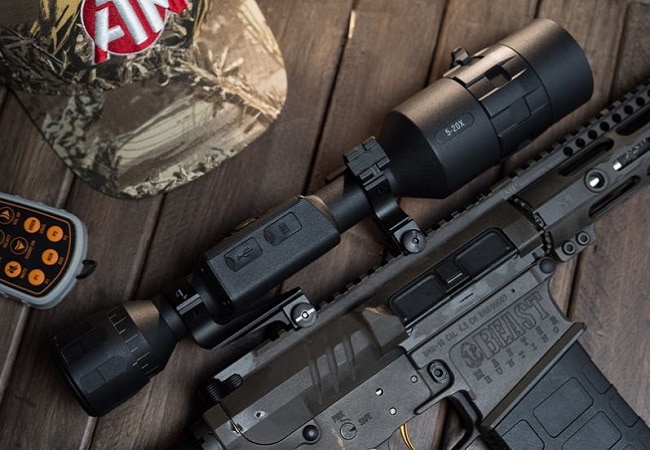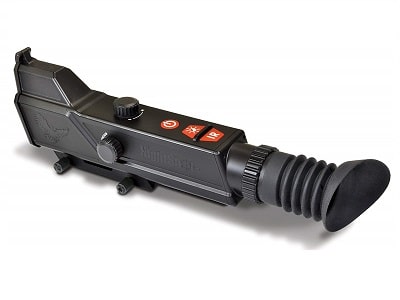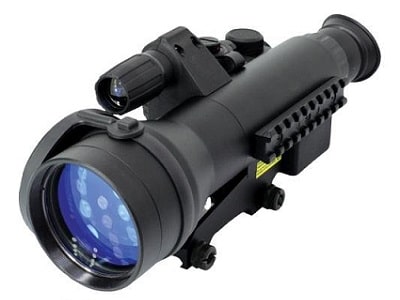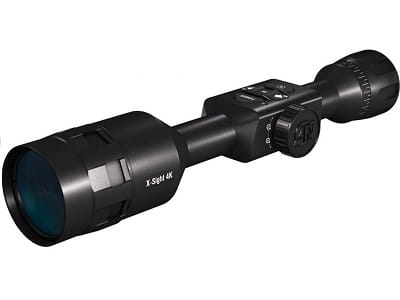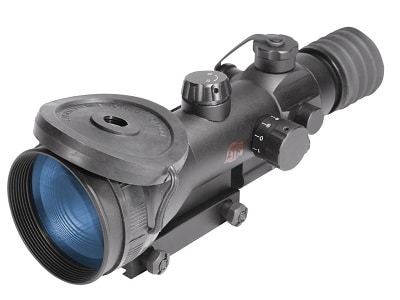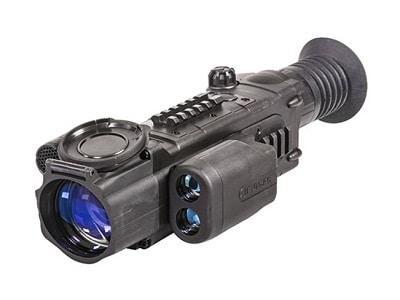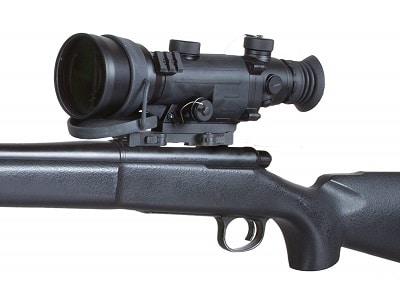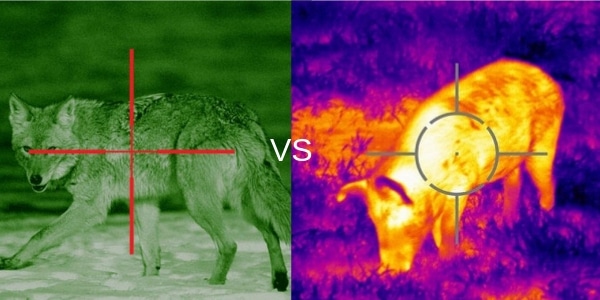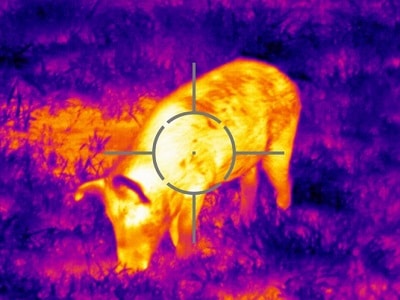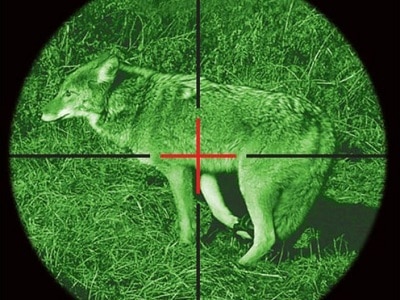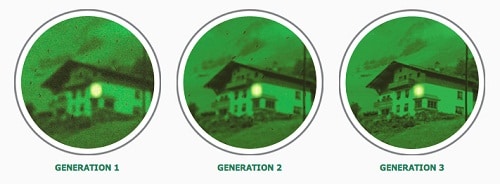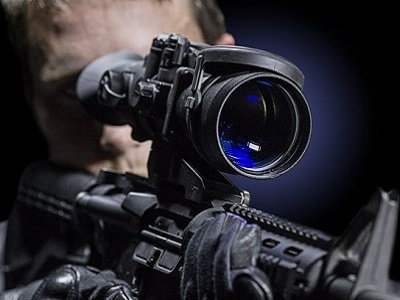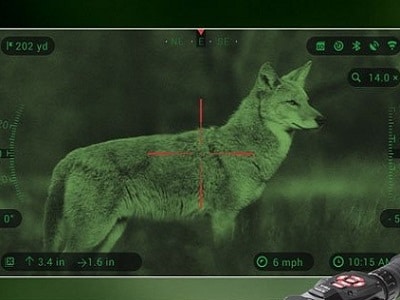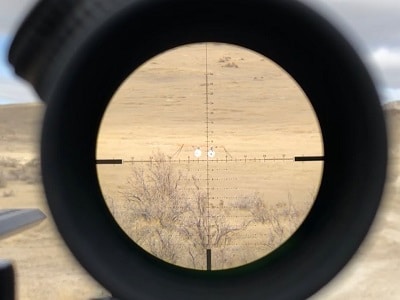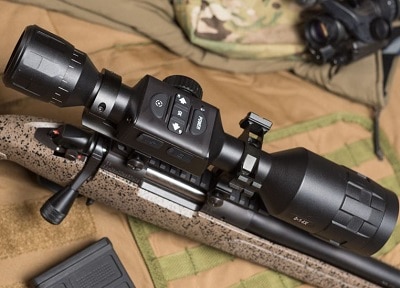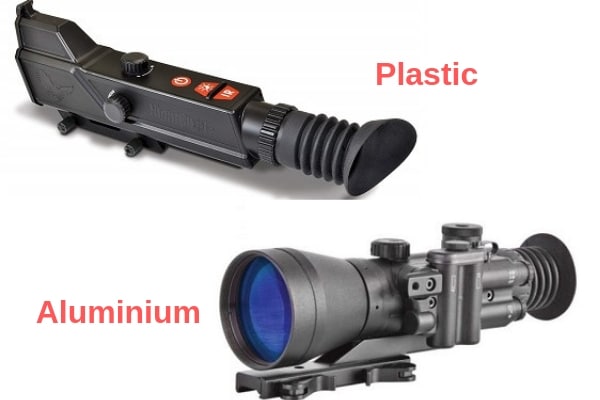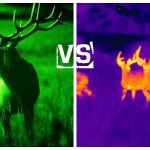Who doesn’t love shooting? We all do, right? But what about at night? Shooting at night can be safe, legal, and fun. One of the keys to safety is the presence of a night vision scope.
Night vision scopes can be used for hunting, target shooting, and even security and tactical work. So how do you find the right one? Well, keep reading and find out from our reviews.
The 9 Top Night Vision Scopes Reviewed
Here is a list of the best night vision scopes of 2019:
- Best under 500 #1: ATN X-Sight 2 HD
- Best under 500 #2: Night Owl Nightshot
- Best under $1,000 #1: Sightmark Night Raider
- Best under $1,000 #2: Armasight Vampire
- Best for the Money #1: Sightmark Photon RT 4.5-9×42
- Best for the Money #2: ATN X-Sight 4K
- Best Overall #1: Night Optics Argus
- Best Overall #2: ATN Ares 4-4
- Best for the AR-15: Pulsar Digisight N960 LRF
| Category | Best under 500 | Best for the money | Best overall |
|---|---|---|---|
| Product | 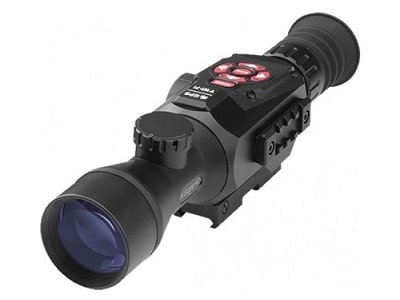 |  | 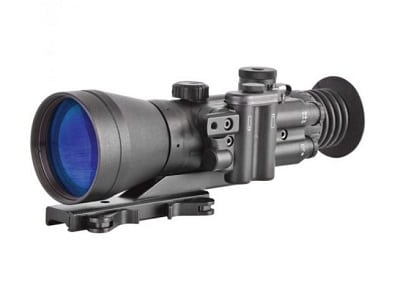 |
| Generation | Digital | Digital | 4th Generation |
| Magnification & Objective Diameter | 3 - 14 x 50mm | 4.5 - 9 x 42 mm | 4x 100mm |
| Battery Life | 2 hours | 3.5 hours | 60 hours |
| Weight | 2.15 lb | 30.7 oz | 38 oz |
| Resolution | 160 lp/mm | 768x576 CMOS | 72 lp/mm |
| Price | Check Price | Check Price | Check Price |
1. Best Night Vision Scope Under $500 #1: The ATN X-Sight 2 HD
Digital night vision can be an excellent way to save money and maximize performance. The ATN X-Sight 2 is a digital night vision scope that can be used in both the day and night.
The X-Sight-2 is packed with tons of different features and applications to make hunting and shooting a lot easier. The X-Sight 2 HD boasts a resolution just a hair below a Generation 2 device, but is still priced at under $500.
The X-Sight 2 has a 3-14 power magnification that allows you to zoom in and easily identify a target, look for movement, or differentiate between targets.
This is a digital zoom, so the reticle is always accurate in terms of bullet drop. The built-in rangefinder is one of the coolest features and will automatically adjust your point of aim when calibrated properly. Some other features that caught my eye are:
- Built-tin rangefinder, barometer, and compass
- Can stream over wifi
- Can film 1080p video and take photos
- Compatible with Android and iOS devices
Pros
- Can be used in the day or night
- Recoil activated video setting
- Can use a tablet or phone as a viewfinder
- Easy to use, perfect for beginners
Cons
- Very large unit
- Digital magnification is not as clear as analog magnification
The X-Sight 2 is a great optic for hunting in the right conditions, but on completely moonless nights or very dark nights, it won’t catch a Gen 2, 2+, or Gen 3 devices in terms of clarity.
The X-Sight is a great option for just having fun as well, and the video recording ability is great if you want to show your shots or record your own performance.
2. Best Under $500 #2: The Night Owl Nightshot
The Night Owl Nightshot is another digital night vision scope that recently hit the market. It’s a great little optic that is priced well below $500 and is a great overall value.
The Nightshot comes with a built-in Picatinny mount and is designed for rifles up to 30 caliber. That covers almost all hunting rifles for medium game.
The Nightshot comes with a built-in IR illuminator and a large hinged lens cap to protect the optic while not in use. You get to choose from three different reticles and a fixed three-power magnification.
The scope even used digital adjustable windage and elevation dials to make the transition from day to night scope easy. The clicks each represent a ¼ MOA turn at 100 yards. The Nightshot is a little big size-wise, but only weight 1.3 pounds.
Features
- Made from strong thermoplastic
- Runs on four double A Batteries
- 100- to 200-yard effective range depending on nighttime conditions
- High-resolution display
- Built-in IR Illuminator
Pros
- Affordable and high quality
- Weatherproof
- Easy to transition to
- Perfect for new shooters and new night vision users
Cons
- Low battery life (two hours with high IR, five hours with low IR)
The Nightshot is perfect for new night vision users. It’s great as a just-for-fun optic, or even pest removal and hunting at close ranges. It’s easy to use and perfect for modern rifles. The design is simple and quite rugged for the price.
3. Best Night Vision Scope Under $1,000 #1: The Sightmark Night Raider
Sightmark makes a number of interesting and well-made night vision optics that are fascinating in design. The Sightmark Raider is a little simpler than most but it is a robust and interesting optic for hunting and night-time observation.
The hunter has a lower three power but packs a 60mm objective lens. The big lens helps with clarity and field of view, which is critical in hunting situations.
The Sightmark Night Raider is a Gen 1 device, so expect Gen 1 performance. That being said, the design really strives for a clear image with such a big objective lens.
The Night Raider has a stabilized battery source which prevents recoil from interrupting the battery source during recoil. The Night Raider boasts impressive performance for a Gen 1 device and its 200-yard effective range is perfect for medium- to close-range shooting.
Features
- Built-in IR illuminator
- Built-in Picatinny rail for IR Spotlight
- IPX4 waterproofing
- 35 ll/mm resolution
Pros
- Very easy to use
- Clear image in typical conditions
- Affordable and powerful
- 70-hour battery life
Cons
- Gen 1 device has limited range on overcast nights
The Sightmark Night Raider is a robust and powerful optic for hunting in most conditions, its best used for hunting predator animals like coyotes and bobcats, and of course pest removal.
The integrated IR light is a godsend on those dark nights, and the optic is easy to mount and use.
4. Best Under $1,000 #2: The Armasight Vampire
Vampire is probably one of the best names for a night vision optic. Armasight capitalized on this one well. The Vampire is an interesting optic with a distinct IIT Core.
This CORE generation is designed to maximize the potential of an optic without getting into the Gen 3 price range. It can deliver near Gen 3 resolution, though. The Armasight Vampire has a 60-70 LP/MM resolution that’s crystal clear and bright.
The Vampire is a three power scope, and it uses a simple crosshair reticle. The scope will put you on target quickly and place shots with precision.
The Armasight Vampire has an all-aluminum housing that is dust and water resistant—this adds weight, but I’d say the weight is worth the extra durability
Features
- Built-in IR illuminator
- Picatinny rail for accessories
- Low battery indicator
- High resolution
- Low battery indicator
Pros
- 40 hours on a single battery
- Easy to mount an IR laser
- Rock-solid aluminum housing
- Affordable and high resolution
Cons
- Heavy weighs over three pounds
The Armasight Vampire is a great optic for the price. Its high resolution gives you an unbeatable picture with a considerably lower price than most.
The Vampire is hefty but easy to attach to modern rifles. It’s also relatively short, even if it’s bulky. It would be perfect for hunting medium game like feral hogs and even for some basic home and property defense. The Vampire certainly owns the night.
5. Best Night Vision Scope for the Money #1: The Sightmark Photon RT 4.5-9×42
The Sightmark Photon is one of those interesting designs I mentioned earlier. This optic looks futuristic (oddly small and compact) and it’s also quite lightweight.
The photon uses a traditional scope design, or as close as you can get with a night vision scope. This lowers its profile and makes it more intuitive for most. There are different models of this scope, but the 4.5 to 9 magnification rating gives the most value in my opinion.
This is a digital night vision optic that gives an excellent 150-yard performance. The 4.5x is true magnification, and everything beyond that is digital magnification.
The Photon is compatible with standard 30mm scope rings, and the low profile allows them to be mounted quite low. The Sightmark Photon is a great choice if you want to keep your rifle slim and sleek.
Features
- 6 different reticles and four different colors
- Built-in IR illuminator
- Built-in sound and video recording capability
- Compatible with most smart phones
Pros
- Excellent range for such an affordable optic
- Picatinny rail for an IR laser is a nice touch
- Shockproof and IPX5 water resistant
- Can be used during the day
Cons
- Short battery life
The Sightmark Photon is a great optic for short-range hunting, and even better for shooting small targets at night. It’s best served on a modern style rifle with a full-length scope rail, as it is rather long.
The multitude of reticle options and the high resolution make it easy to accommodate a variety of different guns and rounds.
6. Best for the Money #2: The ATN X-Sight 4K
We already named one of the many different kinds of X-Sights above, but the X-Sight 4K is a step above the under $500 model. The 4K model gives you a much higher magnification rating and a much clearer picture.
The 1080p high definition is great, but 4K is much clearer, especially when we start with digital zoom. The 4K is packed with Ultra HD sensors and ATN’s Obsidian 4 Dual Core processor for both a crystal clear picture and fast optics.
The ATN X-Sight 4K is a compact optic that mounts on both the smaller rails of a bolt action and on the longer rails of a rifle like the AR15.
The ATN X-Sight is a digital night vision device and one of the best of its kind. It’s crystal clear and easy to use, and best of all it’s an affordable weapon optic for a variety of different purposes.
Features
- Wifi and streaming enabled
- Can record video, audio, and take pictures
- Built-in ballistic calculator
- 5-20x magnification
Pros
- Long battery Life
- iOS and Android compatibility
- Stream and record video at the same time
- Recoil activated video
- Can be used during the day
Cons
- A heavy 2.2 pounds
- Internal battery so they can’t be swapped in the field
The ATN X-Sight 4K is a powerful digital night vision device. It’s designed to bring the highest clarity possible to digital night vision.
The X-Sight is a powerful optic that’s perfect for hunting, especially for those who want to record their kills as well as casually record their nature viewing.
It’s somewhat expensive for a digital night vision, but the number of features in the optic makes it well worth the money.
7. Best Overall Night Vision Scope #1: The Night Optics Argus
When it comes to getting the best of the best the night optics, Argus is easily one of the clearest and brightest optics out there. It’s a 4th Generation night vision device that is extremely powerful and consistently clear.
The Argus is a fixed four-power optic with a large objective lens. The Argus is a powerful optic that will deliver you a crystal clear picture with very little light needed.
The Argus weighs 38 ounces, but the harder aluminum body makes it tough and not just waterproof but completely submersible up to 66 feet. The Argus is special operations capable and priced accordingly. Night optics really did their work when they developed this optic. It’s packed with features, and here are just a few:
- 72 lp/mm
- Waterproof to 66 feet
- Ultra-fast auto gating
- Mil-Dot reticle for easy windage and elevation compensation
Pros
- One of the clearest optics on the market
- Variable brightness reticle
- Extremely durable
- Wide field of view
Cons
- That’s one heavy price tag
The Argus is for serious use. Sure you can hunt with it, but in reality, this optic is for police, military, and tactical use.
This level of clarity won’t just get you on target but will allow to positive identify facial features down to small scars and when they shaved last. This is a crystal clear optic designed for professionals doing hard jobs, and the price reflects that.
8. Best Overall #2: ATN Ares 4-4
Ares was the Greek God of War, master of combat and all around badass, and if you name an optic after him, you better back it up. The ATN Ares 4-4 certainly deserves it.
This Generation 4 optic gives you the power to cut through the darkness like a knife through butter. The resolution is a brilliant 72 lp/mm, and you won’t miss the fine details with the Ares fixed 4x magnification.
The Ares really is made for war. From its rugged design and housing to its long battery life and relatively lightweight design, the Ares is a go to hell, come back, and go again optic. It just keeps running, and when push comes to shove, the Ares is no weakling.
It makes hitting targets (both stationary and moving) easy, and it allows the user to have the ability to identify their target with extreme clarity before eliminating it effectively.
- 4x fixed magnification
- 30 hours from 1 AA battery
- Detachable infrared illuminator
- 7.5-degree field of view
Pros
- Built-in bright light cut off
- Automatic brightness control
- Hard to beat the clarity
- Not the most expensive Gen 4 optic
Cons
- Bulky
9. Best Night Vision Scope for the AR-15: Pulsar Digisight N960 LRF
The AR-15 is America’s most popular rifle, and many of you are likely searching for a night vision scope for an AR-15. Without a doubt, any of the optics above could do the job, but are they the best for the AR-15?
Since AR-15s come in all shapes, sizes, and budgets, I wanted to find a good compromise on price and quality, and I think the Pulsar Digisight N960 LRF scope is perfect for the AR-15. It’s a digital night vision scope with excellent clarity and a low profile.
The Digisight is a variable optic with a magnification range of 3.5 to 14x. The Pulsar Digisight has an integrated laser rangefinder. It’s also recoil-proof and perfect for calibers a lot larger than 5.56.
The optic is equipped with various reticles and the ability to save three separate zeroes. It has a built-in Picatinny rail mount. Best of all, it can be used during the day safely for a 24-hour optic.
Features
- Multitude of reticles
- Integrated laser rangefinder
- Wide field of view
- Weighs only 2.2 pounds
Pros
- Affordable and reliable
- One shot zeroing feature
- Rail for adding accessories like a miniature red dot
- Multiple reticle colors
Cons
- Short battery life
This is a great modern rifle scope. It’s intuitive, easy to use, and versatile. These same considerations are what make the AR-15 such a popular rifle. The Pulsar Digisight is a great all-around optic and is one of the best we can advise for the AR-15 platform.
The Importance of a Quality Night Vision Scope
The good thing about capitalism is you can find an option for every use and price range, and the bad thing is trying to find a good night vision scope.
However, it’s important you do. A bad product will make it awfully hard to hit the target, especially if you can’t tell what it is.
When it comes to actually shooting, there is the rule to always be sure of your target and what’s behind it. If you can’t even tell what your target is, you shouldn’t be pulling the trigger.
A good product means you have the ability to see and tell what your target is. This is why you have to be picky when it comes to night vision scopes: you are putting them on a firearm or weapon of some kind.
You also want an optic that’s precise and zeroes easily. This goes back to hitting your target. The fact that it’s a scope is just as important as the fact that it’s a night vision device. It needs to be able to work as a scope as much as it does a night vision device.
How Does Night Vision Work
Magic?
Not quite, but night vision really is a technological wonder. What this tech does is boost the ambient light that’s both visible and invisible to create a picture.
Night vision devices can pick up ambient light from the moon, stars, and other similar sources, as well as invisible infrared light. Light enters the goggles and hit a thingamajig called a photocathode. This photocathode turns to light, which is made of photons, into electrons.
These electrons are then amplified by a photomultiplier. This creates tons more electrons. These electrons then hit a phosphor screen, where they create bright flashes of light. Those bright flashes of lights of so numerous and so constant it forms a picture.
That picture is light amplified and greenish in color. Night vision tech has evolved and shrunk over time, and different generations incorporate small differences in lenses, technology, and coatings, but the principle remains the same.
Night vision relies on some form of light, be it visible or infrared. In situations where there is absolutely no light, then night vision goggles won’t work.
Night Vision vs. Thermals
Night vision and thermal scopes have a similar use but in many ways are complete opposites. Thermal devices detect heat and show it through a screen.
They are perfect for finding people and animals as fast as possible. Night vision still relies on your perception to actually find the target.
Both devices are handy, but night vision will give you more detail overall. You can easily identify the fine details of an animal or person with night vision. The same goes for details of an environment.
Thermals can’t tell you where a crossing is, or how deep a hole is, whereas night vision allows you to perceive this. In terms of logistics, thermal optics are much more expensive and quickly suck batteries dry.
They also generally have a shorter range, but the advantage is that they do not rely on moonlight. They can also safely be used during the day.
Night vision makes it easier to detect weapons, facial features, as well as individuals in a group. Some thermal units will turn a group standing close together into one glob of light.
One isn’t necessarily better than the other, as they both have distinct purposes. In my squad in Afghanistan, it wasn’t unusual to have a standard NOD and a thermal unit. They are both strong contenders for night time scopes and it’s really about what you need as an individual.
Click here for full NV and thermal optics comparison.
Night Vision Scope Generations
Night vision scopes come in numerous generations. These generations were invented by the US Military and define the components and quality of the optic. The generations are separated by what type of image intensifier tube is used for that optic.
Gen 1
Gen 1 devices are the cheapest optics out there. They are widely available, and they are mostly for target shooting. They amplify light, but unless it’s used on the clearest of nights, you may need an attached infrared unit.
They are best used for close range shooting. They have a slight whine when used, and may have a blurry edge.
Gen 2
Gen 2 night vision scopes are where you get into more serious use, especially with Gen 2+ optics. Generation 2 night vision devices are where you can easily and safely hunt as well as do security and surveillance work.
Gen 2 devices have a micro-channel plate that creates more electrons for a clearer and brighter picture. These devices are great on gloomy and moonlit nights and will rarely require an infrared device.
Gen 3
Gen 3 devices are where NVG companies add an ion barrier film as well as a chemical known as gallium arsenide. These devices are extremely clear and bright and provide a crisp and clear picture.
Rarely will an IR light be needed. These are the current generation used by the United States military.
Gen 4
Gen 4 isn’t a military recognized generation, but one given by the growing night vision industry. Gen 4 devices are filmless and gated and provide the clearest picture you can get.
In low-light conditions, you can’t get a clearer picture than Gen 4 devices. The downside is the extreme price difference.
How to Choose A Right Night Vision Scope?
When it comes to choosing the right scope for you and your needs, you have to examine a few key factors. You have to be honest with your expectations as well as your budget in terms of how you want to use your system.
It’s much better to spend a little more than to obtain a system that just doesn’t work for you and be out a whole lot more money.
Budget
The first thing we need to examine is your budget. How much do you have to spend? Night vision devices of all kinds are expensive, and night vision scopes can be a little more advanced in terms of use and function. This requires a bit more money than something simple like a monocular.
A scope has to pack in magnification. This includes a digital reticle (and possibly multiple reticles), as well as a means to mount it to a rifle.
This all brings up the cost of the optic and makes night vision scopes a hair more expensive than your standard night vision device.
Inside the category of scopes, you also have to evaluate your budget, with some going for several hundred dollars and others going for several thousand. Like with most things, the sweet part is in the middle.
Past your middle-of-the-road optics, you start getting diminishing returns and the only shooters who would need a several thousand dollar scope are the kind that shoot guys like Osama Bin Laden.
Use Case
Next, you have to examine what you want to use the system for. Shooting for fun is a lot different than hunting. If you are just shooting for fun, there is very little concern about the optic. Sure you want one that works, but it’s not a life-or-death scenario.
Recreational use
You can go with a cheaper optic with a lower overall clarity and simpler design. The use of night vision optics for plinking and recreational shooting is common, and you don’t need a top of the line optic—unless you want one, of course.
Hunting
Hunting is another growing use for night vision scopes. The feral hog population is booming in the United States, and most states now allow the pursuit of hogs after the sun goes down.
This has led to a massive interest in night vision scopes for killing these creatures. Other people using these devices are not specifically hunting animals, but defending their animals from predators.
In these situations, you want a crystal clear optic with a moderate amount of magnification. You want a crisp image to be sure you are shooting a legal animal.
You can’t just shoot a green blob and hope it’s a hog, or coyote, or whatever. You have to be sure of your target when you pull that trigger. This means you need a clearer optic, something in the high-end digital vision space (Gen 2 and up).
As a hunter, you are going to be in the field, which means exposure to the elements, potential falls, dust, and even moisture. In this case, you are going to want an optic that’s a bit tougher than most.
You’ll also want an IR illuminator for times where the trees block out the moonlight, or the moon simply isn’t bright. An IR illuminator is a must-have tool for hunting with night vision.
Tactical
Tactical use of nightvision is almost always offensive in nature, and in this consideration it is also a piece of gear you have to stake your life on.
There is also the condition dealing with other people’s lives. In this case, you need the clearest view possible. You can’t mistake a guy holding a hotdog for a handgun and take a shot.
This means you have to go with optics that are Gen 2+ at the very least, and easily into Gen 3 and 4 scopes. These optics also allow for surveillance and observation of a target as well.
Taking a shot is not always necessary, so you want the ability to observe and report as well. Half of a sniper’s job is just scouting and reporting.
An optic for hunting will work well with shooting for fun, and an optic for security or police work will do all three well. What you can’t always do is take an optic designed for plinking and target shooting and expect it to be the best device for hunting.
To identify what works with your purpose, you need to examine important considerations like a product’s features, its resolution, and its performance in situations with no ambient light. These are critical to successful shooting.
Resolution
The resolution of a night vision optic is defined in several different ways. Specifically, resolution with night vision is the ability of a device’s intensifier system to tell the difference between different objects that are close together.
Resolution is explained and measured in line pairs per millimeter, expressed as LP/MM. The higher the number, the higher the resolution—and generally the sharper and clearer the image will be.
Resolution is measured from the center of the optic, and near the edges you can always expect to see some distortion and lack of clarity.
The resolution of a device is typically tied to the optic’s generation. The higher the generation, the greater clarity you will have.
Resolution does not affect how bright the image will be, or incorporate no ambient light testing. Some devices need less ambient light, but that’s not a factor of resolution measurement.
Other effects on perceived resolution will be the signal-to-noise ratio, or SNR. Noise, also called scintillation, is that little bit of almost TV like static you see through an optic.
It’s normal and does affect the clarity of your picture. It’s more present in low light scenarios and will change as the light around you and your target changes.
Magnification
How far are you planning to shoot is a big consideration as well. Shooting in the dark is hard enough, but it gets harder with little to no magnification when it comes to distance.
Unlike day optics, you won’t be seeing optics that have massive 25 power magnification levels. Typically you’ll see magnification top out at around 15x with digital zoom.
The issue with magnification and night vision is it reduces some of the image’s clarity. Most shooters aren’t shooting far enough to need some crazy level of magnification in the middle of the night.
A good 6 power will solve most shooters problems and allow them to see far enough to identify a target. In some scenarios, you may actually want less magnification.
In scenarios where you are shooting at close range the extra magnification is going to slow you down and make it hard to see your target.
The more magnification a scope has, the heavier, longer, and more expensive it will likely be. It really helps to range your typical shots and know what you need before you buy a night vision scope.
External Considerations
You also want to look at how strong and durable an optic is. Will it withstand the recoil of your particular weapon? The force generated from an AR 15 in terms of recoil is minimal.
The force that comes from a 338 Lapua is much more significant. A big question you have to ask is: will it withstand the recoil of your particular weapon? Companies will often tell you if it’s rated for light, moderate, or heavy recoil.
Remember, these optics are a combination of glass and electronics, which are both fragile by themselves.
What is its water and dust resistance? If your optic is going to be exposed to the environment, you need to consider what it will be able to withstand. This is critical.
When I was a young buck, I killed an expensive night vision optic because I assumed a military-grade device would be waterproof. It was not. Luckily, Uncle Sam footed the bill, but I learned a lesson.
Water-resistant and waterproof are two different things. The same goes for dust and debris. If it’s sealed for water, it’s sealed for dust. However, if you don’t know, it’s best not to assume.
Is the body aluminum or plastic?
Aluminum bodies resist drops, falls, and kicks better than plastic. They also cost a pretty penny more. Plastic bodies are great for budget sets and for plinking and light hunting, but when things get serious, go aluminum.
Ending Words
These are all things you need to consider to strike the right balance between price and utility.
Finding the right night vision scope doesn’t have to be hard. Isolate your needs and your budget, and then consider the options that fill those roles. It can be confusing, but if you take your time and examine the investment, you’ll be good to go.

